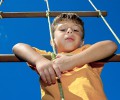Disorganized and Remarkably Organized
When it comes to being organized there are a lot of steps involved. Organization is an executive functioning skill and some brains are higher functioning in this area than others. Being disorganized can be very stressful and is often misunderstood. Despite frequent reminders, your child may shove papers in their backpack everyday or leave homework items strewn all over the dining room table without packing up.
The Flip Side trait of being both disorganized and remarkably organized can be really confusing! How can your child be organized one day but not the next? Or maybe they are organized with something that is important to them but not with something you think is important like passing in homework. This paradox is why children often get labeled with being lazy and then take on that label which never serves anyone well. So what can be done?
Punishment will not change disorganized behaviors that are related to brain neurology so definitely don’t go down this path!
Instead, help your child develop strategies for organization. This will involve helping your child “see” themselves “doing” all the steps necessary for organization. When organizational skills are weakened your child is unable to visualize themselves going through all the necessary steps. If your child can’t see themselves doing the task then it becomes nearly impossible to make it happen. When we are working with children on organizational strategies here is what we do:
- Start by asking your child how they define organization.
- Secondly, ask them to identify an area of their life where they feel organized. This could be anything including a playlist on their phone. Ask them for details on what their organizational system is. For example, if your child is organized with their sports equipment they definitely have a system. Using hockey for example your child may go through a toe to head mental checklist starting with skates, shin pads, socks, etc. If you don’t ask you may never know they actually have a system!
- Thirdly, help your child take strategies that already work and apply them to areas that need help. For example, if your child is naturally good at visualizing, they might try a mental checklist at the end of the day when considering what they need to take home. They can start with the class they had at the start of the day and work down. If your child likes everything in one place they might want to try an accordion folder rather than separate binders or folders.
- Mapping out every step in the process is key. Your child needs to visualize, draw, talk it out, or write down all of the steps involved in an organizational task. When your child can see themselves doing each step from start to finish they are more likely to follow through.
- Provide reminders or help your child create their own. This isn’t about nagging, this is about asking your child if they would like you to be involved in helping them follow through. This might be a cue word or the last thing you say when they get out of the car or when they leave the house. Your child might create their own reminder by using sticky notes, writing themselves notes in their notebook ahead of time, setting an alarm on their phone, texting themselves a reminder, or setting up reminder notifications.
Monitoring progress is critical for success.
Data doesn’t lie!
If the goal is to get work turned in, then the evidence of a successful strategy is the work is actually turned in. Expect that you may need to help your child tweak their strategy just a bit as the ADHD brain sometimes gets bored with the same old strategy. Make it a learning opportunity so they can expect that a strategy that works may need to be changed just a little bit to keep it interesting to the ADHD brain.
As always comment here and let us know your child’s favorite strategy!
P.S. If you haven’t gotten our Executive Functioning Tool designed for your child or teen grab it here.









